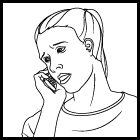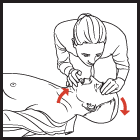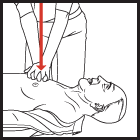What Is CPR (Cardiopulmonary Resuscitation)
CPR is combination of rescue breathing(to get oxygen to the lungs) and chest compressions (to keep blood circulating) delivered to victims to save of patient life when a person experiences cardiac arrest, whether due to heart failure in adults and the elderly or an injury such as near drowning,suffocation, poisoning, smoke inhalation, electrocution or severe trauma in the child and newborn.
Cardiac arrest is often caused by an abnormal heart rhythm called ventricular fibrillation (VF). When VF develops, the heart quivers and doesn't pump blood. The victim in VF cardiac arrest needs CPR and delivery of a shock to the heart, called defibrillation. Defibrillation eliminates the abnormal VF heart rhythm and allows the normal rhythm to resume. Defibrillation is not effective for all forms of cardiac arrest but it is effective to treat VF, the most common cause of sudden cardiac arrest.
CPR may not save to the victim even when performed properly, but if started 4 minutes of cardiac arrest and defibrillation is provided whitin 10 minutes, a person have 40% chance of survival. Here the CPR time line described you have to do CPR , if you are doing CPR starting 0-4 minutes you can save from brain damage, 4-6 minutes brain damage possible happen, 6-10 minutes brain damage probable and over 10 minutes probable brain death, so choose the right time when you are perform CPR.
To make learning CPR is easier , you have to remember the sequence letters A-B-C as explained the following:
CPR is most successful when administered as quickly as possible, but you must first determine if it's necessary. It should only be performed when a person isn't breathing or circulating blood adequately.
How to perform CPR?
You should not try CPR unless you have had training - if it is done incorrectly, it could harm someone and will killing victim try to looking some help or you can calling victim, you have to be skill full, and to keep your skill up, you should repeat the training every two years. You can call 9-1-1 in USA, UK 9-9-9 or you can call any Emergency Care in your own country, or you can contact local Ambulance number if you have it.
If yo can do CPR, Remember the ABCs
Airway, Breathing and Circulation — to remember the steps explained below.
AIRWAY: Clear the airway
Rescue breathing can be mouth-to-mouth breathing or mouth-to-nose breathing if the mouth is seriously injured or can't be opened.
sources
1.www.mayoclinic.com
2.www.learncpr.org
3.www.americanheart.org
Cardiac arrest is often caused by an abnormal heart rhythm called ventricular fibrillation (VF). When VF develops, the heart quivers and doesn't pump blood. The victim in VF cardiac arrest needs CPR and delivery of a shock to the heart, called defibrillation. Defibrillation eliminates the abnormal VF heart rhythm and allows the normal rhythm to resume. Defibrillation is not effective for all forms of cardiac arrest but it is effective to treat VF, the most common cause of sudden cardiac arrest.
CPR may not save to the victim even when performed properly, but if started 4 minutes of cardiac arrest and defibrillation is provided whitin 10 minutes, a person have 40% chance of survival. Here the CPR time line described you have to do CPR , if you are doing CPR starting 0-4 minutes you can save from brain damage, 4-6 minutes brain damage possible happen, 6-10 minutes brain damage probable and over 10 minutes probable brain death, so choose the right time when you are perform CPR.
To make learning CPR is easier , you have to remember the sequence letters A-B-C as explained the following:
- A : Airway
- B : Breathing
- C : Circulation
CPR is most successful when administered as quickly as possible, but you must first determine if it's necessary. It should only be performed when a person isn't breathing or circulating blood adequately.
You should not try CPR unless you have had training - if it is done incorrectly, it could harm someone and will killing victim try to looking some help or you can calling victim, you have to be skill full, and to keep your skill up, you should repeat the training every two years. You can call 9-1-1 in USA, UK 9-9-9 or you can call any Emergency Care in your own country, or you can contact local Ambulance number if you have it.
If yo can do CPR, Remember the ABCs
Airway, Breathing and Circulation — to remember the steps explained below.
AIRWAY: Clear the airway
- Put the person on his or her back on a firm surface.
- Kneel next to the person's neck and shoulders.
- Open the person's airway using the head tilt-chin lift. Put your palm on the person's forehead and gently push down. Then with the other hand, gently lift the chin forward to open the airway.
- Check for normal breathing, taking no more than 10 seconds: Look for chest motion, listen for breath sounds, and feel for the person's breath on your cheek and ear. Do not consider gasping to be normal breathing. If the person isn't breathing normally or you aren't sure, begin mouth-to-mouth breathing.
Rescue breathing can be mouth-to-mouth breathing or mouth-to-nose breathing if the mouth is seriously injured or can't be opened.
- With the airway open (using the head tilt-chin lift), pinch the nostrils shut for mouth-to-mouth breathing and cover the person's mouth with yours, making a seal.
- Prepare to give two rescue breaths. Give the first rescue breath — lasting one second — and watch to see if the chest rises. If it does rise, give the second breath. If the chest doesn't rise, repeat the head tilt-chin lift and then give the second breath.
- Begin chest compressions — go to "CIRCULATION" below.
- Place the heel of one hand over the center of the person's chest, between the nipples. Place your other hand on top of the first hand. Keep your elbows straight and position your shoulders directly above your hands.
- Use your upper body weight (not just your arms) as you push straight down on (compress) the chest 1 1/2 to 2 inches. Push hard and push fast — give two compressions per second, or about 100 compressions per minute.
- After 30 compressions, tilt the head back and lift the chin up to open the airway. Prepare to give two rescue breaths. Pinch the nose shut and breathe into the mouth for one second. If the chest rises, give a second rescue breath. If the chest doesn’t rise, repeat the head tilt-chin lift and then give the second rescue breath. That's one cycle. If someone else is available, ask that person to give two breaths after you do 30 compressions.
- If the person has not begun moving after five cycles (about two minutes) and an automated external defibrillator (AED) is available, open the kit and follow the prompts. If you're not trained to use an AED, a 911 operator may be able to guide you in its use. Trained staff at many public places are also able to provide and use an AED. Use pediatric pads, if available, for children ages 1 to 8. If pediatric pads aren't available, use adult pads. Do not use an AED for infants younger than age 1. If an AED isn't available, go to Number 5 below.
- Continue CPR until there are signs of movement or until emergency medical personnel take over.
sources
1.www.mayoclinic.com
2.www.learncpr.org
3.www.americanheart.org




No comments:
Post a Comment